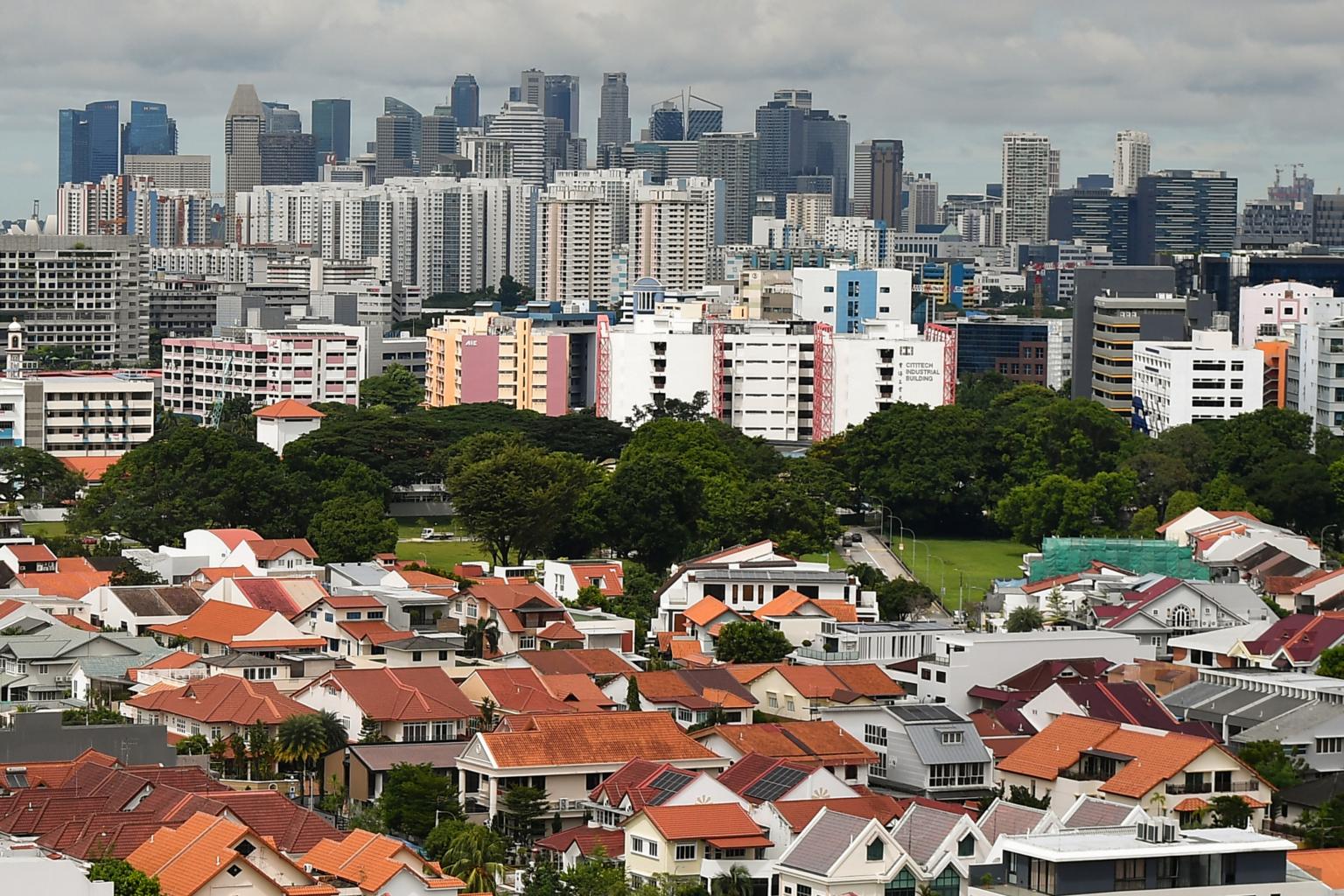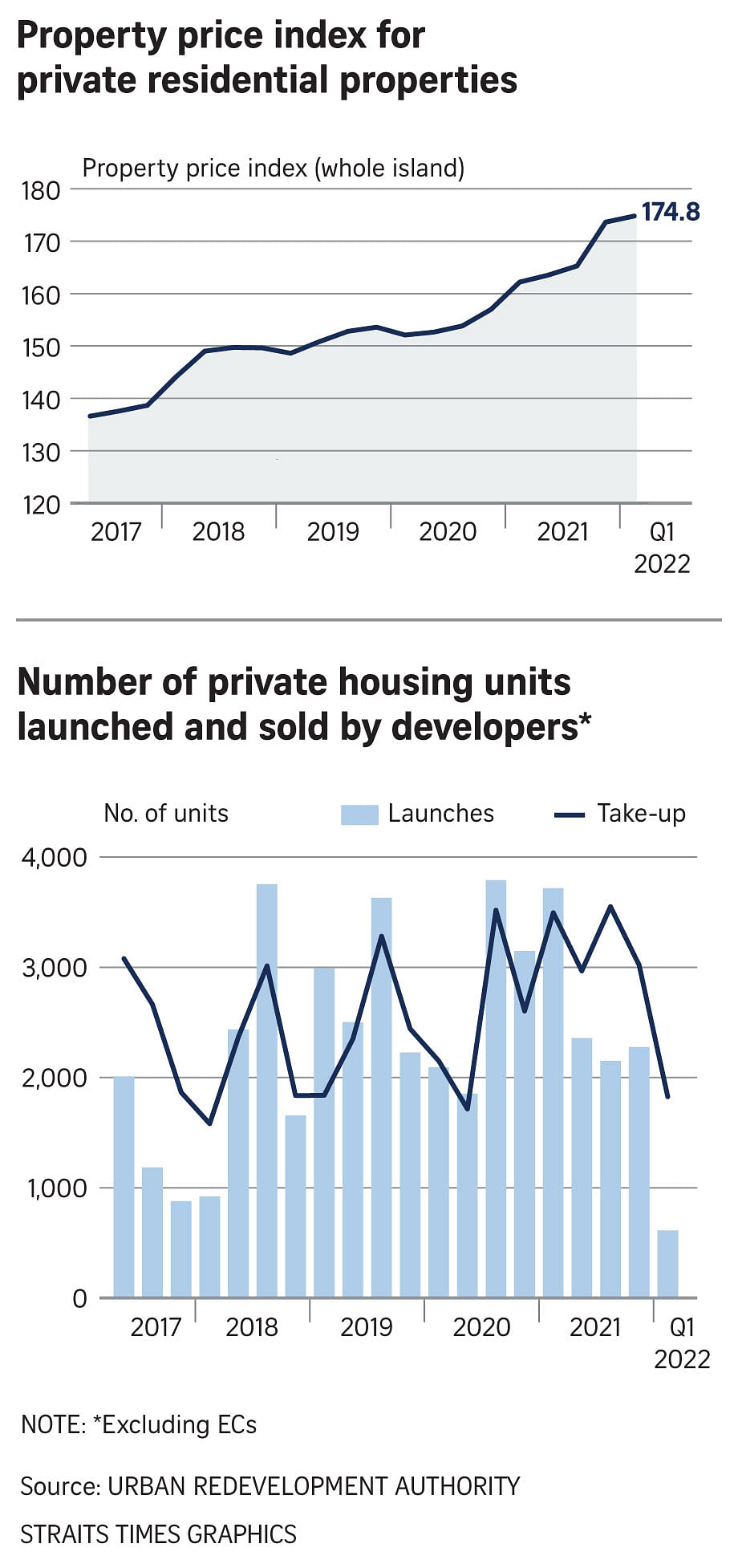Singapore private home price growth, sales slow sharply in Q1 on cooling measures
Sign up now: Get ST's newsletters delivered to your inbox

The latest property cooling measures, a dearth of new major launches and economic uncertainties contributed to the slowdown.
ST PHOTO: LIM YAOHUI
Follow topic:
SINGAPORE - The red-hot private residential market slowed to a crawl in the first quarter of this year as December's property cooling measures took effect amid rising interest rates and the fallout from the Russia-Ukraine conflict.
Private home prices managed to eke out a gain for the eighth straight quarter, rising 0.7 per cent, above the flash estimate of 0.4 per cent for the January to March quarter.
Even so, this marked the slowest quarterly increase since the second quarter of 2020 when prices grew 0.3 per cent. This was also a sharp slowdown compared with the 5 per cent price jump in the fourth quarter of last year.
Overall, private home prices have surged 14.9 per cent since they hit bottom at the start of the pandemic in the first quarter of 2020.
Demand is likely to remain relatively subdued in the second quarter as buyers size up the latest cooling measures, analysts say.
But sales could pick up substantially on new launches and if Singapore’s reopening picks up. In the near term, the private home market could also benefit from safe-haven investment flows amid heightened geopolitical uncertainty.
Ms Catherine He, head of research for Colliers in Singapore, noted: “As this is the first data point post cooling measures, and given that the first quarter is traditionally a slower quarter, this moderation in growth is to be expected.”
But prices and sales may pick up in the second quarter with new launches such as the 407-unit Piccadilly Grand, 298-unit LIV@MB and 268-unit Sceneca Residence, and with the reopening of Singapore’s borders, she said.
Sales of new private homes, excluding executive condominiums (ECs), dropped nearly 40 per cent in the first quarter to 1,825 units, from 3,018 units in the fourth quarter, as foreign buyers and investors held off after the new property curbs.
"Many investors are grappling with higher additional buyer's stamp duty (ABSD) rates imposed on buyers holding multiple properties and rising interest rates that may erode their rental income," OrangeTee & Tie senior vice-president of research and analytics Christine Sun said.
“Cost pressures may play a more significant role in the coming months. Escalating energy, steel, raw material and shipping costs arising from the Russia-Ukraine war and political sanctions may drive construction costs higher," she said.
Mr Ong Teck Hui, senior director of research and consultancy at JLL, flagged the 47 per cent quarter-on-quarter plunge in private residential transactions to foreign buyers to 150 units.
The proportion of foreign buyers has been slowing, from 5.5 per cent in 2019 to 3.7 per cent in 2020 and 3.4 per cent in 2021, he noted.
“Purchases by foreign buyers accounted for 2.9 per cent of total private transactions in the first quarter, down from 3.6 per cent in the fourth quarter last year,” he said.
Developers launched far fewer new homes for sale in the first quarter - 613 units excluding ECs, compared with 2,275 units in the previous quarter.
No new EC units were launched for sale in the first quarter, but 131 EC units from existing projects were sold. This compared with 260 EC units sold in the fourth quarter.
Landed home prices grew 4.2 per cent in the first quarter, up from 3.9 per cent in the fourth quarter, supported by limited stock and sustained activity in the good class bungalow market, said CBRE head of research for South-east Asia Tricia Song.
She also cited strong demand at the launch of strata-landed project Belgravia Ace, which moved 74 units, or nearly 70 per cent of a total of 107 units, at a median price of $1,080 per sq ft.
In contrast, the overall non-landed property market fell 0.3 per cent compared with a 5.3 per cent jump in the fourth quarter.
The drop was led by the city fringe sub-market, which fell 2.7 per cent in the first quarter, reversing a 6.7 per cent gain in the fourth quarter.
This was likely due to a normalisation in prices following the strong sales of CanningHill Piers in the fourth quarter last year, Ms Song said.
Prime district prices shed 0.1 per cent in the first quarter compared with a 2.7 per cent gain in the previous quarter, as the new property curbs dampened interest from foreign investors, she added.
Only the suburban mass market segment showed gains in the first quarter, as demand from HDB upgraders outpaced supply. But prices grew by just 2.2 per cent, compared with a 5.7 per cent increase in the fourth quarter.
ERA Realty’s head of research and consultancy Nicholas Mak noted that there were no new launches in the suburbs in the first quarter.
“The number of unsold uncompleted private residential units in the suburbs also fell to 3,890 units, an all-time low,” he said.
Given sluggish sales in the primary market, resale transactions made up a bigger proportion of total sales at 63.2 per cent in the first quarter, up from 59.9 per cent in the previous quarter.
Colliers’ Ms He said this was significantly higher than the typical quarterly average of around 55 per cent.
“The resale market saw healthy interest amid construction delays and the widening price gap between new launches and resale properties,” she said.
In the absence of new launches in the first quarter, unsold inventory (excluding ECs) dwindled further from 14,154 units in the fourth quarter last year to 14,087 units - the lowest level since the third quarter of 2017 (16,031 units).
This will likely lead to keen bidding for upcoming government land sales (GLS) sites and small to mid-sized collective sales projects, analysts say.
“Despite higher ABSD imposed on developers, some may still turn to private en bloc sites selectively, if they fail to secure GLS sites or do not find the available GLS sites attractive,” Ms Song said.


